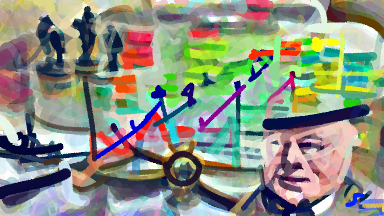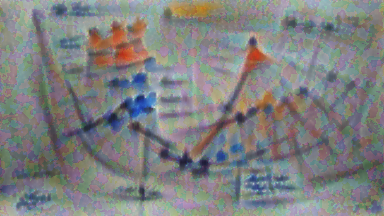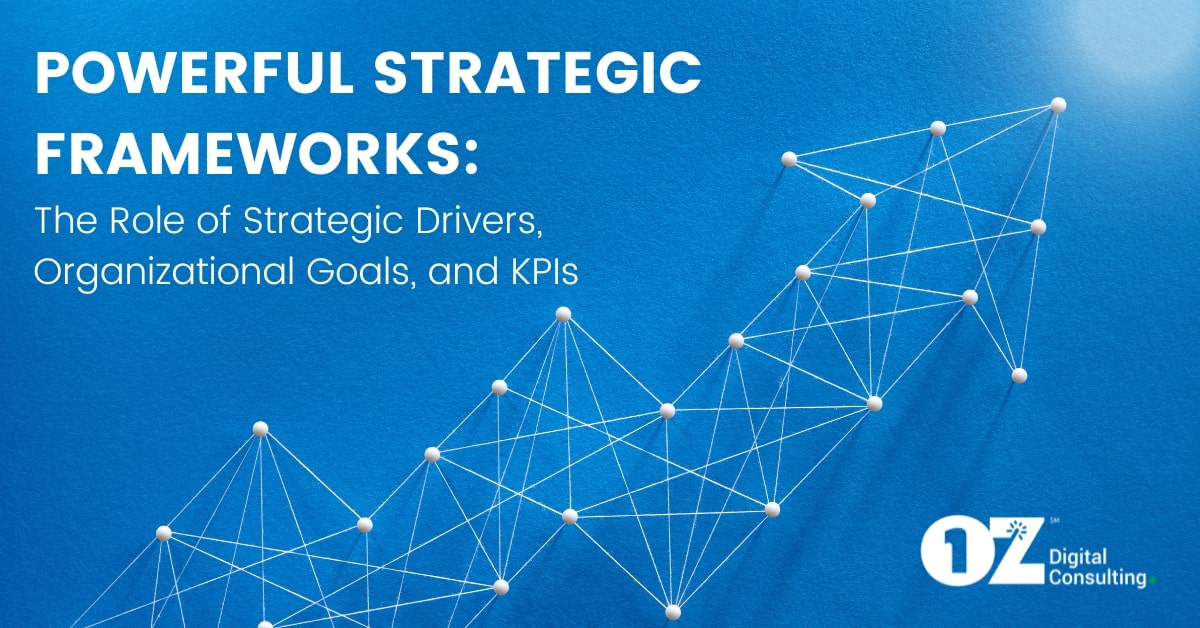
“However beautiful the strategy, you should occasionally look at the results.” –Sir Winston Churchill
How do you ensure that your goals and metrics are in alignment and fully support the overall direction of your company? No, seriously, how do you (and your organization) get alignment to your organization’s aspirational path forward?
As I spoke about in the last article, a company’s vision and mission statements provide the overall direction for the organization and need to be included as base criteria when creating your Strategic Decision Making Framework. These criteria will change infrequently, as they represent the foundational cornerstones of an organization. A vision statement is a future-oriented declaration of an organization’s purpose and aspirations, providing a clear and inspiring picture of what the organization hopes to achieve. A mission statement outlines the organization’s reason for existence, its core values and priorities, and the customers it serves. You should be able to clearly articulate how the initiatives being considered either fully (or less) support the vision and the mission, and the framework criteria that were created to support them. The vision and mission are rocks that may change slowly over time but for successful companies remain near-constant over the long term.
“Sound strategy starts with having the right goal.” –Michael Porter
On the other hand Strategic Drivers, Organizational Goals, and Key Performance Indicators (KPIs) provide the focus and detail needed to turn the vision and mission into a roadmap for success and can (and very often) change every year, or even more often as the pace of business change continues to dramatically increase and thus the goals of the organization change to reflect the new realities.
Some definitions:
- Strategic Drivers are the key priorities and initiatives that an organization focuses on in order to achieve its goals. They are the critical areas of focus that determine the success of an organization’s strategy and they should be aligned with the overall vision and mission. The strategic drivers should be prioritized, and all initiatives should be evaluated against the drivers to ensure they are aligned with the organization’s priorities. For example, a company that is focused on customer experience might identify customer satisfaction as a strategic driver.

- Organizational Goals are the specific outcomes that the organization aims to achieve through its strategy in both the short and long term. They are specific, tangible, and measurable and help to provide focus and direction for the organization. They should also be realistic, considering the company’s resources and capabilities. The key is that they are measurable which means there is a way to determine achievement (or not) – so there needs to be agreement from the beginning on how they will be tracked. For example, a goal might be to increase customer satisfaction by 10% in the next year, which would require a mechanism to track customer satisfaction.
- Key Performance indicators (KPIs) are metrics that organizations use to measure the success of their goals. KPIs should be directly tied to the goals, and they should be chosen carefully to ensure they accurately reflect progress and also reflect the ability to change direction to positively affect them. They provide a means of tracking progress toward the goals and help organizations understand whether they are on track to achieve them. Following on from the examples above, customer satisfaction might be measured using a customer satisfaction survey, and the goal to increase customer satisfaction by 10% in the next year would be tracked using the results of the survey.
A fuller example of these may be something along the lines of:
Strategic Driver: Customer Satisfaction – Provide a positive customer experience that fully meets the needs of customers. [NOTE: There will probably be more than one strategic driver for any company.]
An Organizational Goal that supports that could be: Increase customer satisfaction by 10% over the next year. [NOTEs: 1. There would need to be agreement on how to measure the percentage increase in customer satisfaction. 2. There may (and probably will be) more than one goal per strategic driver.]
And the KPIs that could be used to measure the success of that goal could include:
- Net Promoter Score (NPS)
- Customer Satisfaction Survey Results
- Customer Complaint Resolution Time
- Customer Retention Rate.
You’ll notice that these goals are fairly generic – different companies and different industries will have different and specific Drivers, Goals, and KPIs based on what they are trying to accomplish.
For example, an insurance company that is focused on Customer Satisfaction as a key Strategic Driver could include KPIs such as:
- Customer Satisfaction (CSAT): This score can be measured through customer surveys and feedback mechanisms. (The average CSAT score for the insurance industry is around 76). Insurance Companies that are focused on CSAT might aim to achieve a customer satisfaction score of at least 85%, well above the industry average.
- Renewal Rates: This KPI is a measure of how many customers are choosing to renew their policies with the company, and it is an indicator of customer loyalty and satisfaction. A CSAT-focused insurer might look to achieve a renewal rate higher than 84%, which is the industry average.
- Claims Processing Time: This measures how quickly the company can resolve claims and pay out benefits to policyholders. This is one of the (if not the) leading indicators of customer satisfaction in the insurance industry. Carriers would look to process claims within a specific number of business days. The industry average is about 11 days to settle a claim so a carrier that is focused on customer satisfaction would look to achieve a much shorter average timeframe for claims settlement.
- Net Promoter Score (NPS): The NPS is a measure of customer loyalty and is calculated by asking customers how likely they are to recommend the company to others and then using a formula on the responses to calculate NPS. Any score above 0 is positive, but most companies strive for a much higher and ever-increasing NPS. Insurers might aim to achieve an NPS of at least 5 points above the industry average for that year (the benchmark for Insurance is 71).
 While there are many other insurance industry-focused metrics, not all of them would be directly related back to this specific customer satisfaction-focused goal and strategic driver. Metrics like Average Cost per Claim, Return on Surplus, Loss Ratio, Frequency, Severity, Expense Ratio, Strike Rate, Average Policy Size, and many others are probably metrics that most insurance companies would want to track to support other drivers and goals, but wouldn’t be (necessarily) related to this specific combination of the two.
While there are many other insurance industry-focused metrics, not all of them would be directly related back to this specific customer satisfaction-focused goal and strategic driver. Metrics like Average Cost per Claim, Return on Surplus, Loss Ratio, Frequency, Severity, Expense Ratio, Strike Rate, Average Policy Size, and many others are probably metrics that most insurance companies would want to track to support other drivers and goals, but wouldn’t be (necessarily) related to this specific combination of the two.
Now that we’ve identified all the Drivers, the Goals, and their associated Metrics / KPIs, we need to turn them into criteria for the Framework, and then we need to define what we mean by them and how they are assessed (more about this in future articles). Not every initiative will support every Driver, Goal, and Metric, but ‘better’ initiatives will more fully support more of these criteria and at a higher level than ‘lesser’ initiatives. And since the Metrics are associated with Goals that are associated with Drivers, which then fully support the Vision and the Mission, a straight line can (should?) be drawn from each initiative that is ranked by the framework back to the vision and mission of the organization. If not, chances are it won’t be ranked as highly as others that do.
While some metrics could apply across all (most?) industries (such as Net Promoter Score), different industries have different metrics specific to those industries. A Travel and Hospitality (T&H) company, for instance, may have a similar Customer Satisfaction Driver to the example above, but the Goals and therefore the Metrics would all be different.
An example set for a (again, fictional) T&H company could be:
Strategic Driver: Customer Satisfaction
Goals:
- Increase customer satisfaction ratings by 5% YoY
- Reduce customer complaint resolution time by 50%
- Increase customer loyalty by 10% through repeat bookings for both new and existing loyalty members.
KPIs:
- Net Promoter Score (NPS)
- Average Resolution Time (ART)
- Repeat Booking Rate (RBR)
 Over the years I’ve had discussions about what comes first: Drivers or Goals. My preference is Drivers, which should then lead to Goals that can be measured (as in being able to answer the question, “did we Achieve it or not?”). From my perspective, the approach is to first determine the organization’s Vision and Mission, which provides a clear direction for the organization. From there, strategic drivers are identified, which are the key areas or themes that will help the organization achieve its vision and mission. The strategic drivers provide the focus for setting goals, which are specific and measurable outcomes that the organization seeks to achieve. The goals are then translated into key performance indicators (KPIs), which are measurable metrics that track progress toward the goals. This approach provides a logical and structured framework for aligning the organization’s efforts with its overall strategy. But I’ve worked with clients that create Goals (“Increase revenue by 5% YoY”) first and then determine the Strategic Drivers to support them (“Roll out more frequent incentive programs in Asia”), and that’s fine. As all of these are then translated into criteria for our model, either way will work.
Over the years I’ve had discussions about what comes first: Drivers or Goals. My preference is Drivers, which should then lead to Goals that can be measured (as in being able to answer the question, “did we Achieve it or not?”). From my perspective, the approach is to first determine the organization’s Vision and Mission, which provides a clear direction for the organization. From there, strategic drivers are identified, which are the key areas or themes that will help the organization achieve its vision and mission. The strategic drivers provide the focus for setting goals, which are specific and measurable outcomes that the organization seeks to achieve. The goals are then translated into key performance indicators (KPIs), which are measurable metrics that track progress toward the goals. This approach provides a logical and structured framework for aligning the organization’s efforts with its overall strategy. But I’ve worked with clients that create Goals (“Increase revenue by 5% YoY”) first and then determine the Strategic Drivers to support them (“Roll out more frequent incentive programs in Asia”), and that’s fine. As all of these are then translated into criteria for our model, either way will work.
Vision and mission statements provide the overall direction and purpose of an organization, while strategic drivers, organizational goals, and KPIs provide the specific steps and targets that need to be achieved in order to fulfill that purpose. They are the building blocks of our strategic framework and will drive specific criteria that will be used to evaluate strategic initiatives and options. Those initiatives will then, by definition support the organization and where it is trying to go.
And having everything aligned with where you are trying to go is so very important. As Yogi Berra is quoted as saying:
“If you don’t know where you are going, you might wind up someplace else.”
Hi, I am Murray Izenwasser, the SVP of Digital Strategy at OZ Digital Consulting. If you would like to discuss creating such a framework, contact me – that’s what my team and I do for our clients. In fact, we have a platform that we use with our clients called Launchpad where we do exactly this, as we help them build out their digital strategies. Message me about how we can do this for you.
(And, just as an aside, the images were created by an image AI generator based on the title of this article.)
[Sources for the benchmarks above:
2023 CSAT Benchmarks by Industry: What’s a Good Score? (fullview.io),
Insurance Industry’s 18 Most Critical Metrics – Guiding Metrics,
30+ NPS benchmarks for leading industries in 2023 | QuestionPro)].



